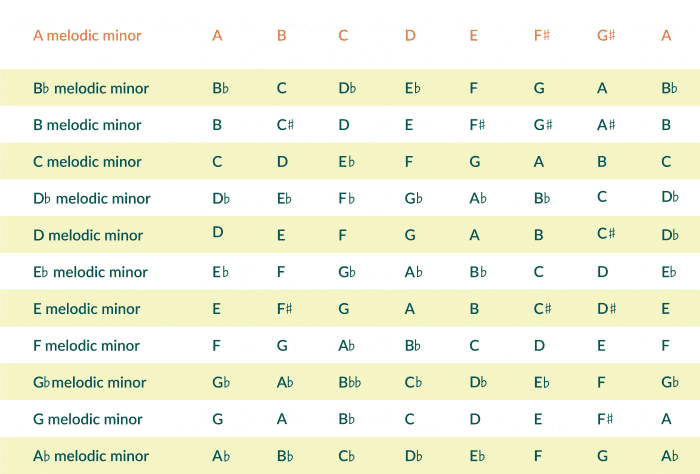The melodic minor scale is a variation on the natural minor scale that emerged primarily because of its melodic functionality, as opposed to its cousin, the harmonic minor scale, which developed based on its harmonic functions. In European classical music, the scale follows one interval pattern ascending and a different interval pattern descending. However, in nearly every other style of music, the melodic minor scale follows one pattern ascending and descending.
The scale produces a series of beautiful, rich harmonies that will add unique depth and timbre to your music. Additionally, learning the scale will open your musical universe to new melodic ideas. Let’s dive into the sound world of the melodic minor scale.

What is the melodic minor scale?
The melodic minor scale is one possible variation on the natural minor piano scale. Remember, we build the natural minor scale from the sixth tone of the major scale. If we are in the key of C major, then the relative natural minor scale will be built from A.
Building the melodic minor scale
The melodic minor scale is essentially a natural minor scale with raised sixth and seventh scale degrees. Remember, the notes of the A natural minor scale are A – B – C – D – E – F – G – A. Basically, all the white keys from A – A like this:
The sixth and seventh tones of the scale are F and G. If we raise each of them by one half-step, our scale will now be spelled A – B – C – D – E – F♯ – G♯ – A. Try playing it on the piano like this:
The melodic minor scale formula
Remember that the scale degree formula for the natural minor scale is:
1 – 2 – ♭3 – 4 – 5 – ♭6 – ♭7
Since the melodic minor scale has raised sixth and seventh scale degrees compared to the natural minor scale, this means that the formula for the melodic minor scale is :
1 – 2 – ♭3 – 4 – 5 – 6 – 7
Not too complicated, right? You could also think of the melodic minor scales as simply major scales with flat third scale degrees. This makes moving between the major and melodic minor scales quite simple, since all you have to do is change one note!
Practice building the melodic minor scale
Now that you understand the basic formula of the melodic minor scale, let’s practice building the scale with a few examples.
- E melodic minor – starting from E, the melodic minor scale will be spelled E – F♯ – G – A – B – C♯ – D♯ – E. It looks like this on the piano
- F melodic minor – starting from F, the melodic minor scale will be spelled F – G – A♭ – B♭ – C – D – E – F. It looks like this on the piano
- D melodic minor – starting from D, the melodic minor scale will be spelled D – E – F – G – A – B – C♯ – D. It looks like this on the piano
- B melodic minor – starting from B, the melodic minor scale will be spelled B – C♯ – D – E – F♯ – G♯ – A♯ – B. It looks like this on the piano
- C melodic minor – starting from C, the melodic minor scale will be spelled C – D – E♭ – F – G – A – B – C. It looks like this on the piano

Ascending vs descending melodic minor scale
In some examples of European classical music, there are two forms of the melodic minor scale: an ascending version and a descending version. The ascending version follows the same pattern and formula that we have learned here. The descending version follows the pattern of the natural minor scale. Therefore, the ascending version of the A melodic minor scale would be spelled A – B – C – D – E – F♯ – G♯ – A while the descending version would be spelled A – B – C – D – E – F♮ – G♮ – A.
Harmonizing the melodic minor scale
The melodic minor scale produces some extremely interesting chords, especially when we extend beyond the triads into the seventh chords. Let’s build a diatonic chord scale from the notes of the A melodic minor to learn the harmonies.
Remember, a diatonic chord scale just means all the basic harmonies or chords that are inherent in a scale. The way we build a diatonic chord scale is by stacking thirds through the scale, which is the same thing as skipping every other note. Remember the notes we will be working with are:
A – B – C – D – E – F♯ – G♯ – A
If we stack thirds to build triads inside the A melodic minor scale, we end up with the following chords and spellings:
- A minor spelled A – C – E
- B minor spelled B – D – F♯
- C augmented spelled C – E – G♯
- D major spelled D – F♯ – A
- E major spelled E – G♯ – B
- F♯ diminished spelled F♯ – A – C
- G♯ diminished spelled G♯ – B – D
As you can see, we have an example of an augmented chord and two examples of diminished chords. This gives us a rich palette of harmonic colors we can use with the melodic minor scale.
Additionally, every melodic minor scale follows this pattern of chords:
Minor, minor, augmented, major, major, diminished, diminished
You can also visualize it on the piano like this:
Melodic minor scale intervallic construction
If remembering scale degree formulas is a little too esoteric for you, you can also use intervals to memorize scale construction. For example, the interval pattern for the major scale is always:
Whole step – whole step – half step –
whole step – whole step – whole step – half step
Since the melodic minor scale is basically a major scale with a flat third scale degree, we will have a nearly identical interval pattern, with a single exception. Can you figure out the interval pattern for the melodic minor scale based on this information?
The interval pattern for the melodic minor scale is:
Whole step – half step – whole step –
whole step – whole step – whole step – half step
You could also analyze the intervals inside of the scale in this manner:
A melodic minor | A | B | C | D | E | F# | G# | A |
| Intervals | P1 | M2 | m3 | P4 | P5 | M6 | M7 | P8 |
In this chart, we can visualize the intervals inside the melodic minor scale from the root, A.
- The second scale degree, B, is a major second away from A (two semitones)
- The third scale degree, C, is a minor third away from A (three semitones)
- The fourth scale degree, D, is a perfect fourth away from A (five semitones)
- The fifth scale degree, E, is a perfect fifth away from A (seven semitones)
- The sixth scale degree, F♯, is a major sixth away from A (nine semitones)
- The seventh scale degree, G♯, is a major seventh away from A (11 semitones)
Songs with melodic minor
The melodic minor scale is found in numerous songs from many genres and styles of music. One great example of the melodic minor scale in Skoove’s piano learning app for adults is found in the most covered tune of all time, “Yesterday” by the Beatles. The ascending melodic figure that included the lyric “All my troubles seemed so far away” is an example of the D melodic minor scale.
Another great melody with an example of the melodic minor scale is the jazz standard “Autumn Leaves”. The melody dances through the G melodic minor scale in the seventh and eighth measures, just as the harmony moves from D dominant 7 to G minor. The melodic minor scale is great to use in situations like this where you have a dominant 7th chord moving to a minor tonic chord.
Melodic minor scale summary
The melodic minor scale is a beautiful and rich sounding scale that will add a new element of depths and mystery to your piano playing. The melodic minor scale is a variation of the natural minor scale that features raised sixth and seventh scale degrees. In European classical music, the scale sometimes has an ascending form that differs from the descending form. But, in most other styles, the melodic minor scale remains the same ascending as descending.
Remember, whether you are just diving into the world of scales and chords or are a more advanced player looking to deepen their mastery of music, Skoove offers piano lessons for every taste. With over 400 interactive lessons on repertoire, theory, and technique, plus a growing collection of articles, you will certainly notice big improvements in your playing with Skoove!
Author of this blog post:

Eddie Bond is a multi-instrumentalist performer, composer, and music instructor currently based in Seattle, Washington USA. He has performed extensively in the US, Canada, Argentina, and China, released over 40 albums, and has over a decade experience working with music students of all ages and ability levels.















